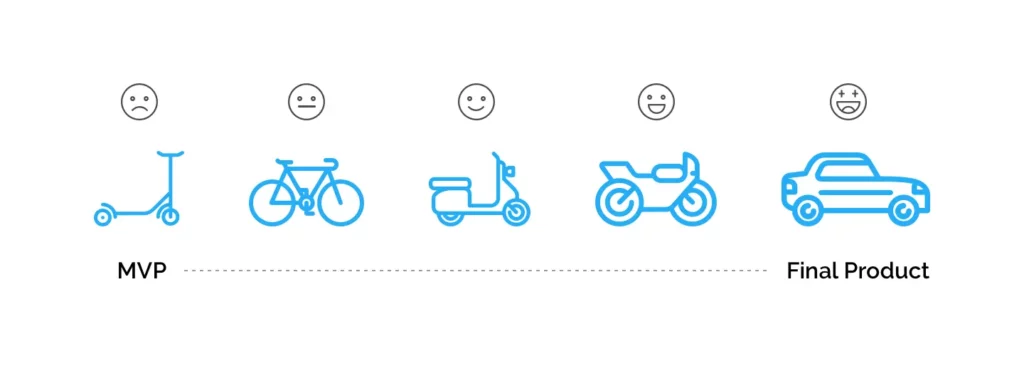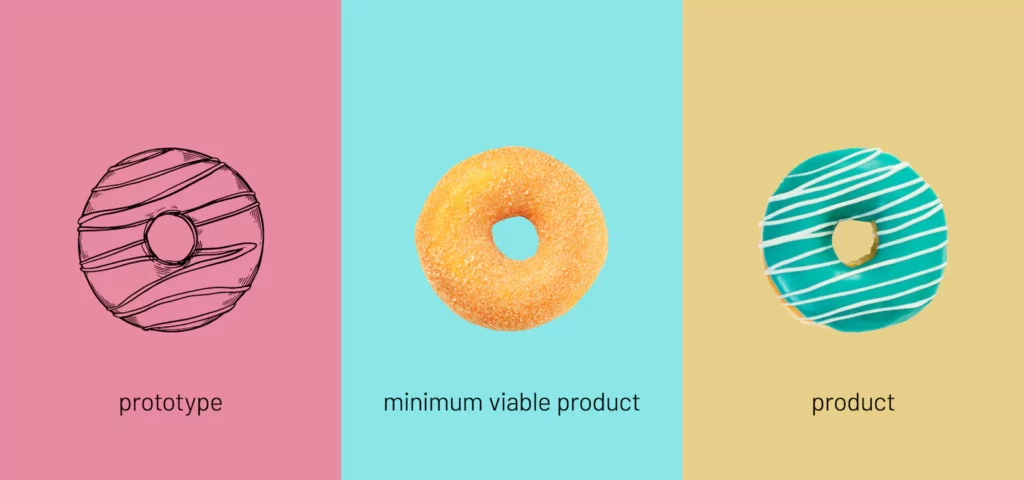In the fast-paced world of startups and product development, understanding what a minimum viable product is can be the key to success. So, what is a minimum viable product? It’s the fundamental version of a new product that helps entrepreneurs test their ideas in the real world. But why is this important? Because it allows them to gather valuable feedback, iterate, and refine their product.
In this article, we will explore the ABCs of MVP, providing a clear and concise explanation of what a minimum viable product is and why it matters in today’s business landscape.
What is a Minimum Viable Product?
Let’s begin by unraveling the central question: What is a minimum viable product (MVP)?
Definition
In essence, a minimum viable product, often abbreviated as MVP, is the most basic version of a new product that a business or startup can create. It’s the fundamental embodiment of an idea, designed to be as minimalistic as possible while still delivering value to users. This simplicity is intentional, aimed at answering a pivotal question: does the market have a demand for this product?
An MVP is not burdened by excessive features or functionalities; instead, it focuses on the core concept. It’s like a prototype, but it goes beyond that, offering a tangible experience to users. It’s all about understanding the concept and its significance.

By stripping away the non-essential elements, an MVP allows a company to validate its idea, gather real-world feedback, and make informed decisions for further development. In other words, it’s a testing ground where entrepreneurs can learn what works and what doesn’t.
Purpose
The purpose of a minimum viable product (MVP) is crystal clear: it’s all about validation. When a business embarks on a new product journey, there’s always a level of uncertainty. They wonder, “Will people want this?” “Is there a market for it?” This is where the concept of MVP shines.
By creating a minimalistic version of their product and releasing it to the public, companies aim to gather data, feedback, and insights from actual users. This data-driven approach allows them to confirm or refute their initial assumptions and hypotheses about the market’s demand.
In practical terms, the purpose of an MVP is twofold: First, it serves as a litmus test for the idea’s viability. Second, it helps avoid the common pitfall of investing significant time and resources into a full-fledged product that might not find a receptive audience.
The beauty of an MVP lies in its agility and flexibility. It enables quick adjustments and iterations based on real-world user experiences. This helps increase the chances of creating a product that resonates with the target audience. Thus, understanding what a minimum viable product is and its purpose is fundamental for any aspiring entrepreneur or product developer.
Recommended reading: Mastering the MVP Development: A Comprehensive Guide for Tech Innovators
Role in startup development
The role of a Minimum Viable Product (MVP) in startup development is multifaceted and pivotal. An MVP is not just a product; it’s a strategic tool that guides startups through their journey to success. Here’s a closer look at its critical functions:
- Validating Business Ideas: An MVP is the compass that helps startups navigate the vast sea of uncertainty. It serves as a litmus test for their business ideas.
- Reducing Time and Costs: Time and resources are precious commodities for startups. Developing an MVP allows them to dip their toes into the market with minimal investment. This lean approach prevents them from pouring valuable resources into features that might not resonate with customers. In other words, it’s an efficient way to explore the market without breaking the bank.
- Focusing on Core Features: An MVP is the epitome of simplicity. It includes only the core features that early customers need. This laser-focused approach ensures that the startup is solving the most pressing problem for its customers. It’s about addressing the “must-haves” before diving into the “nice-to-haves.”
- Attracting Investors and Partners: Startups often need external support, whether it’s in the form of investors or strategic partners. An MVP can be a powerful tool for attracting such support. By demonstrating a genuine demand for their product, startups can significantly enhance their ability to secure funding for further development. Investors and partners are more likely to back a venture with a proven concept.
- Mitigating Risks and Failures: Startups operate in a high-stakes environment where risks are abundant, and failures can be costly. An MVP acts as a safety net. By collecting and analyzing user feedback early on, startups can spot potential issues and make the necessary adjustments. This iterative process helps them mitigate risks and steer clear of costly failures.
Recommended reading: Top 5 Startup Project Management Methodologies in 2023
3 Key Components of an MVP
Now that we’ve grasped the fundamental concept of what a minimum viable product (MVP) is and its pivotal role in startup success, let’s delve deeper.
Identifying core features
One of the fundamental components of a minimum viable product (MVP) is the identification of core features. This is a,so where the heart of the MVP lies, as it involves determining what elements are absolutely essential for the product to fulfill its primary purpose.
Startups, when creating an MVP, must ask themselves: “What are the key functionalities that our target audience needs to address their pain points?” These features must align precisely with the core problem the startup intends to solve.
Identifying core features is additionally an exercise in prioritization. It’s about distinguishing between what’s vital and what’s nice to have. In doing so, the startup ensures that the MVP remains lean and focused, delivering maximum value with minimal complexity.

For example, if a startup is developing a ride-sharing app, the core features might include the ability to request a ride, view driver details, and make payments. Features like a loyalty program or in-app games, while interesting, may not be essential at this early stage.
By pinpointing these core features, the startup lays the foundation for a product that can quickly address user needs and gather valuable feedback. It’s a deliberate and strategic approach that distinguishes an MVP from a full-fledged product.
Minimalistic design
Another critical component of a minimum viable product (MVP) is its minimalistic design. This aspect emphasizes simplicity and user-centricity, ensuring that the product’s design is streamlined for a straightforward and effective user experience.
In the context of MVP development, minimalistic design means focusing on the essentials while eliminating unnecessary complexity. This includes elements like the user interface (UI), navigation, and overall aesthetics. The design should be intuitive and uncluttered, guiding users seamlessly toward the core features and functionalities.
A minimalistic design serves multiple purposes within an MVP:
- Enhanced User Experience: It allows users to interact with the product without distractions or confusion, making their experience more enjoyable and efficient.
- Faster Development: Simplified design often results in quicker development cycles, helping startups get their MVP to market faster and begin gathering valuable feedback sooner.
- Cost Efficiency: By avoiding intricate and time-consuming design elements, startups can save on development costs, which is essential for resource-constrained early-stage ventures.
For example, consider a messaging app MVP. A minimalistic design might feature a clean and uncluttered chat interface, straightforward navigation, and a simple color scheme, focusing solely on the core function of sending and receiving messages.
Rapid development
The third key component of a minimum viable product (MVP) is rapid development. This element embodies the concept of speed and agility in building the MVP to get it into the hands of users as swiftly as possible.
In the context of MVP development, rapid development entails a few critical aspects:
- Quick Iterations: Startups focus on delivering a basic version of the product rapidly and then iterating based on user feedback. This agile approach allows them to make rapid improvements and adjustments.
- Minimal Resources: Rapid development often involves working with lean teams and minimal resources. The emphasis is on achieving the MVP’s core functionality without overburdening the process.
- Time-to-Market: Speed is of the essence. The goal is to reduce the time it takes to go from concept to a functional MVP that can be tested by real users.
For example, imagine a food delivery app startup. Rapid development means creating an MVP that enables users to browse menus, place orders, and make payments. The focus is on these core features, and the app is developed quickly to start collecting user data and feedback.
Additionally, the importance of rapid development in an MVP lies in its ability to expedite the learning process. The sooner an MVP is in the hands of users, the sooner startups can gather insights, validate assumptions, and adapt their product roadmap. This agile approach aligns perfectly with the MVP’s core purpose: to test and refine an idea quickly, efficiently, and effectively.
Recommended reading: How Many Types of Startups Are There?
MVP vs. Prototypes and Beta Versions
To truly grasp what a minimum viable product (MVP) is, it’s essential to distinguish it from two closely related concepts: prototypes and beta versions. While these terms share similarities, they serve distinct purposes in the product development journey. Understanding the differences and nuances between MVPs, prototypes, and beta versions is crucial for entrepreneurs and product developers aiming to make informed decisions about their development strategies. In this section, we’ll explore how MVPs compare and contrast with prototypes and beta versions, shedding light on when each approach is most appropriate and why.
Clarifying the differences
Now, let’s clarify the differences between a Minimum Viable Product (MVP), prototypes, and beta versions. While these terms often intersect in the realm of product development, they serve distinct purposes:
- MVP (Minimum Viable Product): An MVP is the embodiment of the core concept with just enough features to satisfy early customers. It’s functional and aims to provide valuable feedback for future development. The critical distinction is that an MVP treats the basic concept as already proven, focusing on testing the product itself. MVPs are usually released to a select group of users, either publicly or privately.
- Prototypes: Prototypes are early models or releases designed to test a concept or process. They often emphasize the visual appearance of the product, serving as a means to communicate ideas to design and engineering teams. Prototypes can vary widely in complexity, from simple sketches to interactive models. Their primary role is to facilitate communication and idea validation.
- Beta Versions: Beta versions are early releases of a product that typically include all features but may have bugs and issues. They serve to validate the software’s functionality and quality. Beta versions are released to a subset of users who provide feedback on performance before the product’s public launch.
Generally, an MVP is about testing the product’s core functionality and market viability, while prototypes focus on visual and conceptual validation, and beta versions aim to refine a product’s functionality and quality based on user feedback. Understanding these distinctions is essential for effectively implementing each approach in the product development process
When to use each approach

Knowing when to use each approach—MVP, prototypes, or beta versions—is essential for effective product development:
- MVP (Minimum Viable Product): Deploy an MVP when you have a concept you believe solves a real problem and need to validate it in the market quickly. This approach is ideal when you want to test core functionalities and gather user feedback to refine your product’s direction.
- Prototypes: Choose prototypes when your focus is on visualizing and communicating ideas. Prototypes are especially useful in the early stages of design and concept development. They help stakeholders understand the product’s look and feel without investing in full development.
- Beta Versions: Opt for beta versions when your product is nearing completion but requires real-world testing and validation before a public launch. Beta testing allows you to identify and fix bugs and fine-tune the user experience. It’s a valuable step to ensure a smooth product launch.
FURTHER READING: |
1. 6 Best Progressive Web Apps Examples (PWAs) over the Past Decade |
2. 80 Mobile App Ideas to Earn Big Money [Updated for 2023] |
Conclusion
Understanding what a minimum viable product (MVP) is empowers entrepreneurs and product developers to navigate the complex landscape of innovation with clarity and purpose. An MVP is also not merely a buzzword; it’s a strategic approach to product development. Indeed, it’s about creating a lean, focused version of a product that can swiftly test the waters of the market, gather feedback, and adapt accordingly. Through the ABCs of MVP—identifying core features, minimalistic design, and rapid development—startups can refine their concepts, reduce risks, and save resources.
Furthermore, recognizing the distinctions between MVPs, prototypes, and beta versions is crucial. Each serves a unique role in the product development process, with MVPs focusing on core functionality, prototypes on visualization and communication, and beta versions on refinement through testing.
Ultimately, the success of a startup or product often hinges on its ability to efficiently validate ideas, adapt to market demands, and deliver value to users. Embracing the concept of MVP is not just about what it is, but also about how it shapes the future of innovation. It’s a mindset that prioritizes learning, agility, and user-centricity. So, as you embark on your entrepreneurial journey or product development endeavors, remember the ABCs of MVP—they might just be the keys to unlocking your success in the ever-evolving world of business and technology.








